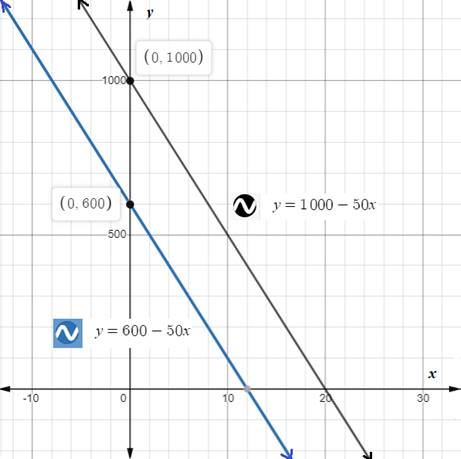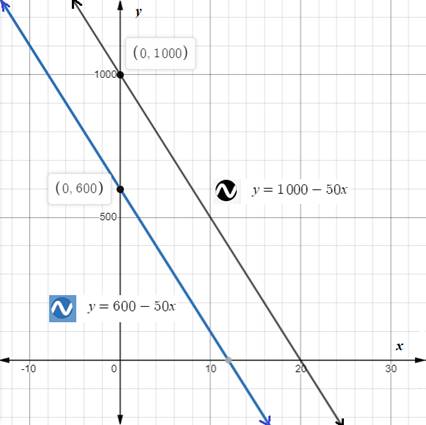
Concept explainers
a.
To write:
An equation giving the unharvested area y of the larger field (in acres) after x days.
a.
Answer to Problem 31E
The equation
Explanation of Solution
Given:
Two farmers each harvest 50 acres of corn per day from their fields. The area of one farmer’s field is 1000 acres, and the area of the other farmer’s field is 600 acres.
Calculation:
Let x represent number of days and y represent unharvested area.
We have been given that the farmer harvest 50 acres of corn per day from their fields, so number of acres harvested in x days would be
The unharvested area after xdays would be total area minus area harvested in x days. The larger area is 1000 acres.
Therefore, the equation
b.
To write:
An equation giving the unharvested area y of the smaller field (in acres) after x days.
b.
Answer to Problem 31E
The equation
Explanation of Solution
Given:
Two farmers each harvest 50 acres of corn per day from their fields. The area of one farmer’s field is 1000 acres, and the area of the other farmer’s field is 600 acres.
Calculation:
Let x represent number of days and y represent unharvested area.
We have been given that the farmer harvest 50 acres of corn per day from their fields, so number of acres harvested in x days would be
The unharvested area after x days would be total area minus area harvested in x days. The smaller area is 600 acres.
Therefore, the equation
c.
To graph:
The equations from part (a) and part (b) in the same coordinate plane. Identify the slope and y -intercept of each graph.
c.
Answer to Problem 31E
Our required graph would look like:

Explanation of Solution
Given:
Two farmers each harvest 50 acres of corn per day from their fields. The area of one farmer’s field is 1000 acres, and the area of the other farmer’s field is 600 acres.
Concept used:
The equation of a line in slope-intercept form is
Calculation:
Upon comparing equation
Upon comparing equation
Upon graphing our both equations on same coordinate plane, we will get our required graph as shown below:

d.
What is the geometric relationship between graphs from part (c)? How do you know?
d.
Answer to Problem 31E
The area under the graph of
Explanation of Solution
Given:
Two farmers each harvest 50 acres of corn per day from their fields. The area of one farmer’s field is 1000 acres, and the area of the other farmer’s field is 600 acres.
Calculation:
Upon looking at our graph in part (c), we can see that the graph of
Therefore, the area under the graph of
e.
How long does it take to harvest the corn in the larger field? in the smaller field?
e.
Answer to Problem 31E
It will take 20 days to harvest the corn in the larger field.
It will take 12 days to harvest the corn in the smaller field.
Explanation of Solution
Given:
Two farmers each harvest 50 acres of corn per day from their fields. The area of one farmer’s field is 1000 acres, and the area of the other farmer’s field is 600 acres.
Calculation:
To find the number of days, it will take to harvest the corn in the larger field, we will substitute
Therefore, it will take 20 days to harvest the corn in larger field.
To find the number of days, it will take to harvest the corn in the smaller field, we will substitute
Therefore, it will take 12 days to harvest the corn in smaller field.
Chapter 8 Solutions
Holt Mcdougal Larson Pre-algebra: Student Edition 2012
Additional Math Textbook Solutions
Introductory Statistics
Elementary Statistics (13th Edition)
Elementary Statistics: Picturing the World (7th Edition)
College Algebra with Modeling & Visualization (5th Edition)
Pre-Algebra Student Edition
Calculus: Early Transcendentals (2nd Edition)
- Safari File Edit View History Bookmarks Window Help Ο Ω OV O mA 0 mW ర Fri Apr 4 1 222 tv A F9 F10 DII 4 F6 F7 F8 7 29 8 00 W E R T Y U S D பட 9 O G H J K E F11 + 11 F12 O P } [arrow_forwardSo confused. Step by step instructions pleasearrow_forwardIn simplest terms, Sketch the graph of the parabola. Then, determine its equation. opens downward, vertex is (- 4, 7), passes through point (0, - 39)arrow_forward
- In simplest way, For each quadratic relation, find the zeros and the maximum or minimum. a) y = x 2 + 16 x + 39 b) y = 5 x2 - 50 x - 120arrow_forwardIn simplest terms and step by step Write each quadratic relation in standard form, then fi nd the zeros. y = - 4( x + 6)2 + 36arrow_forwardIn simplest terms and step by step For each quadratic relation, find the zeros and the maximum or minimum. 1) y = - 2 x2 - 28 x + 64 2) y = 6 x2 + 36 x - 42arrow_forward
- Write each relation in standard form a)y = 5(x + 10)2 + 7 b)y = 9(x - 8)2 - 4arrow_forwardIn simplest form and step by step Write the quadratic relation in standard form, then fi nd the zeros. y = 3(x - 1)2 - 147arrow_forwardStep by step instructions The path of a soccer ball can be modelled by the relation h = - 0.1 d 2 + 0.5 d + 0.6, where h is the ball’s height and d is the horizontal distance from the kicker. a) Find the zeros of the relation.arrow_forward
 Algebra and Trigonometry (6th Edition)AlgebraISBN:9780134463216Author:Robert F. BlitzerPublisher:PEARSON
Algebra and Trigonometry (6th Edition)AlgebraISBN:9780134463216Author:Robert F. BlitzerPublisher:PEARSON Contemporary Abstract AlgebraAlgebraISBN:9781305657960Author:Joseph GallianPublisher:Cengage Learning
Contemporary Abstract AlgebraAlgebraISBN:9781305657960Author:Joseph GallianPublisher:Cengage Learning Linear Algebra: A Modern IntroductionAlgebraISBN:9781285463247Author:David PoolePublisher:Cengage Learning
Linear Algebra: A Modern IntroductionAlgebraISBN:9781285463247Author:David PoolePublisher:Cengage Learning Algebra And Trigonometry (11th Edition)AlgebraISBN:9780135163078Author:Michael SullivanPublisher:PEARSON
Algebra And Trigonometry (11th Edition)AlgebraISBN:9780135163078Author:Michael SullivanPublisher:PEARSON Introduction to Linear Algebra, Fifth EditionAlgebraISBN:9780980232776Author:Gilbert StrangPublisher:Wellesley-Cambridge Press
Introduction to Linear Algebra, Fifth EditionAlgebraISBN:9780980232776Author:Gilbert StrangPublisher:Wellesley-Cambridge Press College Algebra (Collegiate Math)AlgebraISBN:9780077836344Author:Julie Miller, Donna GerkenPublisher:McGraw-Hill Education
College Algebra (Collegiate Math)AlgebraISBN:9780077836344Author:Julie Miller, Donna GerkenPublisher:McGraw-Hill Education





